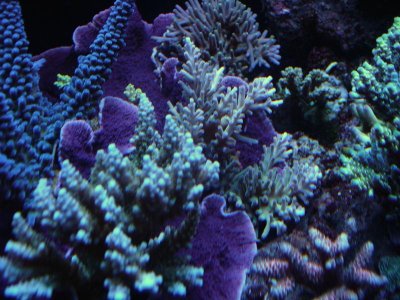DiscusHeckel
Acropora Gardener
My present ATI tubes need replacement at the end of next month. I ordered new ATI tubes from Germany last Friday. They should arrive next week. I ordered:
5 X ATI Blue +; 1 X ATI Aquablue Special; 1 X ATI Purple +; 1 X ATI Actinic; 3 X ATI Coral +
I am going to try Scotty's tube combination first. Having watched his reef videos on big HD screen on numerous occasions, I got convinced that I will like it. I ordered enough tubes to go back to my present combination if needed. Regardless of what I am going to have, there is likely to be an actinic tube in my combination. I am now hoping that the German retailer will send the right tubes and that tubes will arrive in one piece.
To offset part of the purchase cost, I sold a few frags today to local reefers and impressed my wife during this process. She seems to think that I have a good business prowess. I said thank you dear... Acropora yongei seems to be more popular than Acropora aspera and copiosa though.
This is for Sahin:
The "green/blue" Acropora turaki, which we we talked about a few weeks ago, is now sold as "Bottle-brush" acropora by Reefworks. I wrote to Clayton after recognising the picture of the blue "acropora turaki" colony on his web site and ask for explanation. His reply was as follows: "the bottle brush Acropora advertised is the one we previously called A. turaki. However we are not calling it Turaki any more as I believe it was a misidentification. A turaki we get in from Java, it has slightly larger tubular coralites but is very similar looking but I believe a different species." In fact, this coral has always been Acropora carduus :doh:.
5 X ATI Blue +; 1 X ATI Aquablue Special; 1 X ATI Purple +; 1 X ATI Actinic; 3 X ATI Coral +
I am going to try Scotty's tube combination first. Having watched his reef videos on big HD screen on numerous occasions, I got convinced that I will like it. I ordered enough tubes to go back to my present combination if needed. Regardless of what I am going to have, there is likely to be an actinic tube in my combination. I am now hoping that the German retailer will send the right tubes and that tubes will arrive in one piece.
To offset part of the purchase cost, I sold a few frags today to local reefers and impressed my wife during this process. She seems to think that I have a good business prowess. I said thank you dear... Acropora yongei seems to be more popular than Acropora aspera and copiosa though.
This is for Sahin:
The "green/blue" Acropora turaki, which we we talked about a few weeks ago, is now sold as "Bottle-brush" acropora by Reefworks. I wrote to Clayton after recognising the picture of the blue "acropora turaki" colony on his web site and ask for explanation. His reply was as follows: "the bottle brush Acropora advertised is the one we previously called A. turaki. However we are not calling it Turaki any more as I believe it was a misidentification. A turaki we get in from Java, it has slightly larger tubular coralites but is very similar looking but I believe a different species." In fact, this coral has always been Acropora carduus :doh:.





